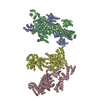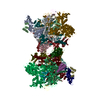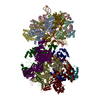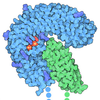+ Open data
Open data
- Basic information
Basic information
| Entry | Database: EMDB / ID: EMD-10689 | |||||||||
|---|---|---|---|---|---|---|---|---|---|---|
| Title | human 17S U2 snRNP | |||||||||
 Map data Map data | ||||||||||
 Sample Sample |
| |||||||||
 Keywords Keywords | 17S U2 snRNP / SPLICING | |||||||||
| Function / homology |  Function and homology information Function and homology informationU11/U12 snRNP / U2 snRNP binding / U7 snRNA binding / histone pre-mRNA DCP binding / U7 snRNP / histone pre-mRNA 3'end processing complex / SLBP independent Processing of Histone Pre-mRNAs / SLBP Dependent Processing of Replication-Dependent Histone Pre-mRNAs / B-WICH complex / protein methylation ...U11/U12 snRNP / U2 snRNP binding / U7 snRNA binding / histone pre-mRNA DCP binding / U7 snRNP / histone pre-mRNA 3'end processing complex / SLBP independent Processing of Histone Pre-mRNAs / SLBP Dependent Processing of Replication-Dependent Histone Pre-mRNAs / B-WICH complex / protein methylation / U12-type spliceosomal complex / 7-methylguanosine cap hypermethylation / poly-ADP-D-ribose modification-dependent protein binding / U1 snRNP binding / methylosome / pICln-Sm protein complex / RNA splicing, via transesterification reactions / snRNP binding / chromatin-protein adaptor activity / blastocyst formation / protein localization to site of double-strand break / small nuclear ribonucleoprotein complex / splicing factor binding / SMN-Sm protein complex / spliceosomal tri-snRNP complex / P granule / telomerase holoenzyme complex / U2-type precatalytic spliceosome / commitment complex / mRNA cis splicing, via spliceosome / telomerase RNA binding / U2-type prespliceosome assembly / U2-type spliceosomal complex / U2-type catalytic step 2 spliceosome / U2 snRNP / RNA Polymerase II Transcription Termination / SAGA complex / U1 snRNP / U4 snRNP / U2-type prespliceosome / positive regulation of transcription by RNA polymerase III / precatalytic spliceosome / regulation of RNA splicing / spliceosomal complex assembly / mRNA Splicing - Minor Pathway / mRNA 3'-splice site recognition / positive regulation of transcription by RNA polymerase I / U5 snRNP / U2 snRNA binding / spliceosomal snRNP assembly / U1 snRNA binding / Cajal body / regulation of DNA repair / U4/U6 x U5 tri-snRNP complex / catalytic step 2 spliceosome / mRNA Splicing - Major Pathway / Gene and protein expression by JAK-STAT signaling after Interleukin-12 stimulation / RNA splicing / stem cell differentiation / spliceosomal complex / positive regulation of neuron projection development / double-strand break repair via homologous recombination / mRNA splicing, via spliceosome / negative regulation of protein catabolic process / B-WICH complex positively regulates rRNA expression / nuclear matrix / fibrillar center / mRNA processing / cytoplasmic ribonucleoprotein granule / site of double-strand break / snRNP Assembly / spermatogenesis / SARS-CoV-2 modulates host translation machinery / RNA helicase activity / nuclear speck / nuclear body / RNA helicase / chromatin remodeling / mRNA binding / positive regulation of DNA-templated transcription / protein-containing complex binding / nucleolus / enzyme binding / positive regulation of transcription by RNA polymerase II / ATP hydrolysis activity / DNA binding / RNA binding / extracellular exosome / zinc ion binding / nucleoplasm / ATP binding / nucleus / cytosol / cytoplasm Similarity search - Function | |||||||||
| Biological species |  Homo sapiens (human) Homo sapiens (human) | |||||||||
| Method | single particle reconstruction / cryo EM / Resolution: 7.1 Å | |||||||||
 Authors Authors | Zhang Z / Will CL | |||||||||
| Funding support |  Germany, 1 items Germany, 1 items
| |||||||||
 Citation Citation |  Journal: Nature / Year: 2020 Journal: Nature / Year: 2020Title: Molecular architecture of the human 17S U2 snRNP. Authors: Zhenwei Zhang / Cindy L Will / Karl Bertram / Olexandr Dybkov / Klaus Hartmuth / Dmitry E Agafonov / Romina Hofele / Henning Urlaub / Berthold Kastner / Reinhard Lührmann / Holger Stark /   Abstract: The U2 small nuclear ribonucleoprotein (snRNP) has an essential role in the selection of the precursor mRNA branch-site adenosine, the nucleophile for the first step of splicing. Stable addition of ...The U2 small nuclear ribonucleoprotein (snRNP) has an essential role in the selection of the precursor mRNA branch-site adenosine, the nucleophile for the first step of splicing. Stable addition of U2 during early spliceosome formation requires the DEAD-box ATPase PRP5. Yeast U2 small nuclear RNA (snRNA) nucleotides that form base pairs with the branch site are initially sequestered in a branchpoint-interacting stem-loop (BSL), but whether the human U2 snRNA folds in a similar manner is unknown. The U2 SF3B1 protein, a common mutational target in haematopoietic cancers, contains a HEAT domain (SF3B1) with an open conformation in isolated SF3b, but a closed conformation in spliceosomes, which is required for stable interaction between U2 and the branch site. Here we report a 3D cryo-electron microscopy structure of the human 17S U2 snRNP at a core resolution of 4.1 Å and combine it with protein crosslinking data to determine the molecular architecture of this snRNP. Our structure reveals that SF3B1 interacts with PRP5 and TAT-SF1, and maintains its open conformation in U2 snRNP, and that U2 snRNA forms a BSL that is sandwiched between PRP5, TAT-SF1 and SF3B1. Thus, substantial remodelling of the BSL and displacement of BSL-interacting proteins must occur to allow formation of the U2-branch-site helix. Our studies provide a structural explanation of why TAT-SF1 must be displaced before the stable addition of U2 to the spliceosome, and identify RNP rearrangements facilitated by PRP5 that are required for stable interaction between U2 and the branch site. | |||||||||
| History |
|
- Structure visualization
Structure visualization
| Movie |
 Movie viewer Movie viewer |
|---|---|
| Structure viewer | EM map:  SurfView SurfView Molmil Molmil Jmol/JSmol Jmol/JSmol |
| Supplemental images |
- Downloads & links
Downloads & links
-EMDB archive
| Map data |  emd_10689.map.gz emd_10689.map.gz | 80.1 MB |  EMDB map data format EMDB map data format | |
|---|---|---|---|---|
| Header (meta data) |  emd-10689-v30.xml emd-10689-v30.xml emd-10689.xml emd-10689.xml | 33.6 KB 33.6 KB | Display Display |  EMDB header EMDB header |
| Images |  emd_10689.png emd_10689.png | 33.7 KB | ||
| Filedesc metadata |  emd-10689.cif.gz emd-10689.cif.gz | 10.5 KB | ||
| Archive directory |  http://ftp.pdbj.org/pub/emdb/structures/EMD-10689 http://ftp.pdbj.org/pub/emdb/structures/EMD-10689 ftp://ftp.pdbj.org/pub/emdb/structures/EMD-10689 ftp://ftp.pdbj.org/pub/emdb/structures/EMD-10689 | HTTPS FTP |
-Validation report
| Summary document |  emd_10689_validation.pdf.gz emd_10689_validation.pdf.gz | 222.6 KB | Display |  EMDB validaton report EMDB validaton report |
|---|---|---|---|---|
| Full document |  emd_10689_full_validation.pdf.gz emd_10689_full_validation.pdf.gz | 221.7 KB | Display | |
| Data in XML |  emd_10689_validation.xml.gz emd_10689_validation.xml.gz | 6.4 KB | Display | |
| Arichive directory |  https://ftp.pdbj.org/pub/emdb/validation_reports/EMD-10689 https://ftp.pdbj.org/pub/emdb/validation_reports/EMD-10689 ftp://ftp.pdbj.org/pub/emdb/validation_reports/EMD-10689 ftp://ftp.pdbj.org/pub/emdb/validation_reports/EMD-10689 | HTTPS FTP |
-Related structure data
| Related structure data |  6y53MC  6y5qMC  6y50C C: citing same article ( M: atomic model generated by this map |
|---|---|
| Similar structure data |
- Links
Links
| EMDB pages |  EMDB (EBI/PDBe) / EMDB (EBI/PDBe) /  EMDataResource EMDataResource |
|---|---|
| Related items in Molecule of the Month |
- Map
Map
| File |  Download / File: emd_10689.map.gz / Format: CCP4 / Size: 103 MB / Type: IMAGE STORED AS FLOATING POINT NUMBER (4 BYTES) Download / File: emd_10689.map.gz / Format: CCP4 / Size: 103 MB / Type: IMAGE STORED AS FLOATING POINT NUMBER (4 BYTES) | ||||||||||||||||||||||||||||||||||||||||||||||||||||||||||||
|---|---|---|---|---|---|---|---|---|---|---|---|---|---|---|---|---|---|---|---|---|---|---|---|---|---|---|---|---|---|---|---|---|---|---|---|---|---|---|---|---|---|---|---|---|---|---|---|---|---|---|---|---|---|---|---|---|---|---|---|---|---|
| Projections & slices | Image control
Images are generated by Spider. | ||||||||||||||||||||||||||||||||||||||||||||||||||||||||||||
| Voxel size | X=Y=Z: 1.16 Å | ||||||||||||||||||||||||||||||||||||||||||||||||||||||||||||
| Density |
| ||||||||||||||||||||||||||||||||||||||||||||||||||||||||||||
| Symmetry | Space group: 1 | ||||||||||||||||||||||||||||||||||||||||||||||||||||||||||||
| Details | EMDB XML:
CCP4 map header:
| ||||||||||||||||||||||||||||||||||||||||||||||||||||||||||||
-Supplemental data
- Sample components
Sample components
+Entire : human 17S U2 snRNP
+Supramolecule #1: human 17S U2 snRNP
+Macromolecule #1: U2 small nuclear ribonucleoprotein A'
+Macromolecule #2: U2 small nuclear ribonucleoprotein B''
+Macromolecule #3: Splicing factor 3B subunit 6
+Macromolecule #4: Probable ATP-dependent RNA helicase DDX46
+Macromolecule #5: Splicing factor 3A subunit 1
+Macromolecule #6: Splicing factor 3A subunit 2
+Macromolecule #7: Splicing factor 3A subunit 3
+Macromolecule #8: Splicing factor 3B subunit 4
+Macromolecule #9: Small nuclear ribonucleoprotein-associated proteins B and B'
+Macromolecule #10: Small nuclear ribonucleoprotein G
+Macromolecule #11: Small nuclear ribonucleoprotein Sm D1
+Macromolecule #12: Small nuclear ribonucleoprotein Sm D2
+Macromolecule #13: Small nuclear ribonucleoprotein Sm D3
+Macromolecule #14: Small nuclear ribonucleoprotein E
+Macromolecule #15: Small nuclear ribonucleoprotein F
+Macromolecule #16: HIV Tat-specific factor 1
+Macromolecule #17: Splicing factor 3B subunit 2
+Macromolecule #18: Splicing factor 3B subunit 1
+Macromolecule #19: U2 snRNA
-Experimental details
-Structure determination
| Method | cryo EM |
|---|---|
 Processing Processing | single particle reconstruction |
| Aggregation state | particle |
- Sample preparation
Sample preparation
| Buffer | pH: 7.9 |
|---|---|
| Grid | Model: Quantifoil R3.5/1 / Material: COPPER / Support film - Material: CARBON / Support film - topology: CONTINUOUS |
| Vitrification | Cryogen name: ETHANE / Chamber humidity: 100 % / Chamber temperature: 277 K / Instrument: FEI VITROBOT MARK I |
- Electron microscopy
Electron microscopy
| Microscope | FEI TITAN KRIOS |
|---|---|
| Image recording | Film or detector model: FEI FALCON III (4k x 4k) / Detector mode: INTEGRATING / Average exposure time: 1.0 sec. / Average electron dose: 72.0 e/Å2 |
| Electron beam | Acceleration voltage: 300 kV / Electron source:  FIELD EMISSION GUN FIELD EMISSION GUN |
| Electron optics | Illumination mode: SPOT SCAN / Imaging mode: BRIGHT FIELD / Cs: 0.01 mm |
| Sample stage | Specimen holder model: FEI TITAN KRIOS AUTOGRID HOLDER / Cooling holder cryogen: NITROGEN |
| Experimental equipment |  Model: Titan Krios / Image courtesy: FEI Company |
- Image processing
Image processing
| Startup model | Type of model: OTHER |
|---|---|
| Final reconstruction | Resolution.type: BY AUTHOR / Resolution: 7.1 Å / Resolution method: FSC 0.143 CUT-OFF / Software - Name: RELION (ver. 3.0) / Number images used: 120070 |
| Initial angle assignment | Type: MAXIMUM LIKELIHOOD / Software - Name: RELION (ver. 3.0) |
| Final angle assignment | Type: MAXIMUM LIKELIHOOD / Software - Name: RELION (ver. 3.0) |
 Movie
Movie Controller
Controller






























 Z (Sec.)
Z (Sec.) Y (Row.)
Y (Row.) X (Col.)
X (Col.)





















